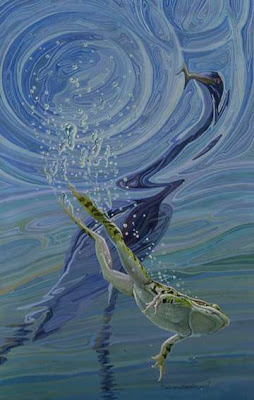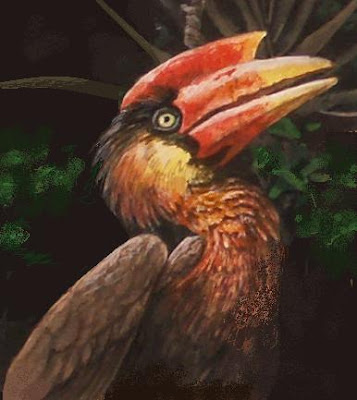 It seems like only yesterday that I promised
It seems like only yesterday that I promised to post part two of my overview of
Bd, aka Chytridiomycosis, the fungal disease that is blamed for much of the amphibian carnage that distresses so many of us today. I fully expected that post to materialize a month or so ago, but events irrelevant to this discussion prevented that. Be that as it may, a late appearance as the first post of 2008 is appropriate, since a consortium of international conservation organizations has deemed this the “year of the frog,” in an effort to raise awareness of the catastrophic situation, my first whiff of which occurred in the spring of 1973, when I witnessed seemingly healthy populations of Northern Leopard Frogs (
Lithobates=Rana pipiens) failing to wake from their winter torpor.
Whether
Bd played a role in that dramatic crash is hard to say, but the recent extinctions of around 122 anuran species are being blamed on it. This flies in the face of conventional ecological dogma, which states that a pathogen cannot directly cause the extinction of a host species, since transmission is density-dependent: as the host population declines, so does transmissibility. The pathogen in this case, the fungus
Batrachochytrium dendrobatidis, seems to persist in waters long after all frogs have died. Presumably, alternate hosts that aren't susceptible to the disease serve as reservoirs, but so far, no such hosts have been discovered. In my earlier
Bd post, I discussed our current state of knowledge, which is so incomplete that designing a plan to thwart it is difficult. What we do know is that
Bd does best in cool temperatures, under 27ºC. It is killed by drying or by prolonged exposure to temperatures over 30ºC. Even so, warming can have unpredictable results. Alan Pounds, who has been studying the cloud forest ecology of Monteverde, Costa Rica for decades, has chronicled a warming and drying trend there which has shrunk the available habitat for cloud forest species, crowding the population, and, he posits, increasing
Bd transmission. This is the same forest where the famous Golden Toad (
Bufo periglenes) mysteriously vanished 30 years ago. Crowding of frogs in breeding ponds has been shown to be important in the spread of
Bd. In western North America, Male Boreal Toads (
Bufo boreas) spend 2-3 weeks in breeding ponds each spring, while the females spend less than 24 hours there. The males always succumb to
Bd long before their mates do. Northern populations of this species are rather tolerant of
Bd, while some others are highly susceptible.
Bd appears to have extirpated the species from New Mexico, and in Colorado, Wyoming and Utah it is considered endangered. Similar mysterious variation in
Bd resistance appears in different populations of Columbia Spotted Frogs (
Rana luteiventris) here in Utah. Perhaps the difference is behavioral. Perhaps it's a difference of antimicrobial skin peptides or microbiota. It's been suggested that the acquired resistance among individual frogs that have been cured of
Bd could be attributable to evolution of probiotic skin microbes.
Pseudomonas reactans, various
Lysobacter spp., and other bacteria that occur naturally on the skin of some frogs have been shown to prevent
Bd infection. The introduction of such microbes to infected waters has been proposed as a means of controlling
Bd.

In California, the two species of Yellow-legged Frog,
Rana muscosa and
R. sierrae have suffered 96% and 92% declines, respectively, although agricultural toxins must bear substantial blame for this. The beautiful Neotropical stub-footed toads (
Atelopus spp.) have been hit particularly hard; it's estimated that 67% of the 110 species, many of which were abundant, have been wiped out. The World Association of Zoos and Aquaria has initiated an effort, christened the “Amphibian Ark” to captively propagate frog species imperiled by
Bd. A number of species extinct in the wild, including the well-known
Atelopus zeteki, are currently being bred in zoos. Less hopeful is Australia's iconic Corroboree Toadlet (
Pseudophryne corroboree - above). Probably extinct in the wild, nearly 5,000 of these frogs linger in captivity, as herpetoculturists vie to be the first to get the species to breed. Hopes for reintroducing them to their small former range in the Australian Alps are faint, since the entire region is rife with Common Eastern Froglets (
Crinia signifera), nearly all them carriers of
Bd. A few other interesting victims of the fungus include the two Australian gastric-brooding frogs (
Rheobatrachus spp.), which died out in the 1980s, and Tanzania's Kihansi Toad (
Nectophrynoides asperginis), whose population went from 18,000 to undetectable during the summer of 2003.
Bd can threaten salamanders as well. It has been linked to die-offs of California Slender Salamanders (
Batrachoseps attenuatus) and Hellbenders (
Chryptobranchus alleganiensis). In the latter species, a grisly communal infection of
Bd and the bacterium
Citrobacter freundii destroys the digits and limbs before killing the host.

Bd cannot be eradicated, but a few things can be done, including:
1.Research. A better understanding
Bd's biology is imperative; how it moves geographically and spreads, the nature of
Bd resistance, and an understanding of how it kills its host, if indeed it does, and how its aetiology is affected by environmental toxins, other pathogens and parasites, etc.
2.Prevent further spread and reduce impact. Of particular interest are regions of great frog diversity and endemism, as well as habitats of the most basal frog species. So far,
Bd does not appear to have reached Madagascar, an island with well over 200 endemic frog species.
3.Promote recovery of threatened species, including captive breeding, restocking of populations, and cryopreservation of gametes. It is possible to cure individuals of many species infected with
Bd. Itraconazole baths have been the preferred treatment for several years, although they adversely affect tadpoles and young metamorphs, and may cause kidney disease. Malachite green and benzalkonium chloride also have an affect on the fungus as does an elevation of temperature. Recent laboratory tests in New Zealand with the antibacterial Chloramphenicol have had very exciting results. This could quickly become the drug of choice.
4.Coordinate hygiene protocols for biologists and recreationists and quarantine strategies for import and export.
5.Spread the word to agencies and the general public.
For more information, visit the
Amphibian Ark site, and while you're at it, sign their
online petition.
_____________________
upper: ASCENSION--STRAWBERRY DART FROG & TADPOLE (2005) acrylic 40" x 15"
center: CORROBOREE TOADLET (1999) acrylic 7" X 7"
lower: PAINTED MANTELLA (2005) acrylic 9" x 7"
 You know Tyrone Hayes, the biologist from UC Berkeley who's been studying the effects of the weed-killer Atrazine for years.
You know Tyrone Hayes, the biologist from UC Berkeley who's been studying the effects of the weed-killer Atrazine for years.













